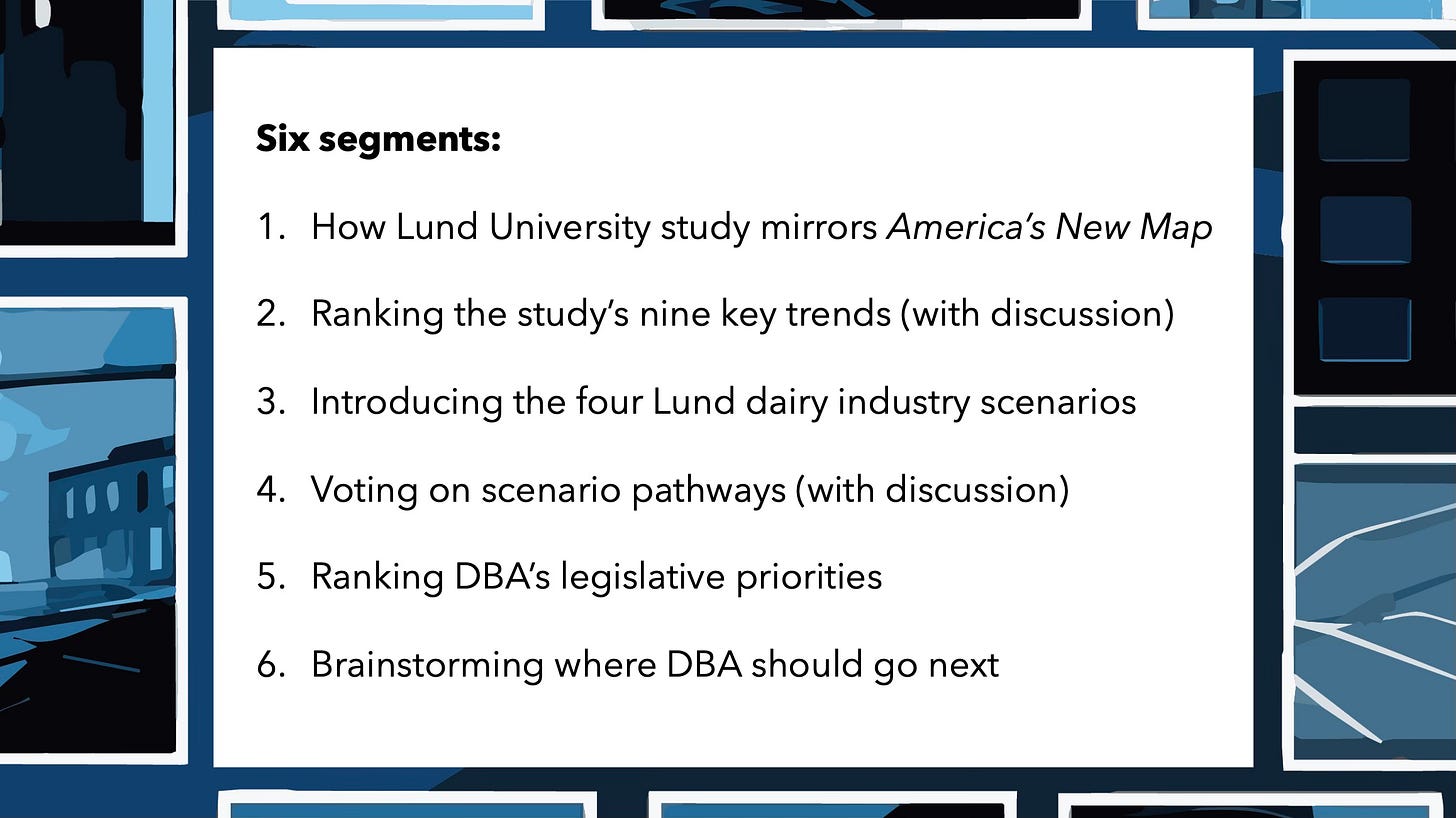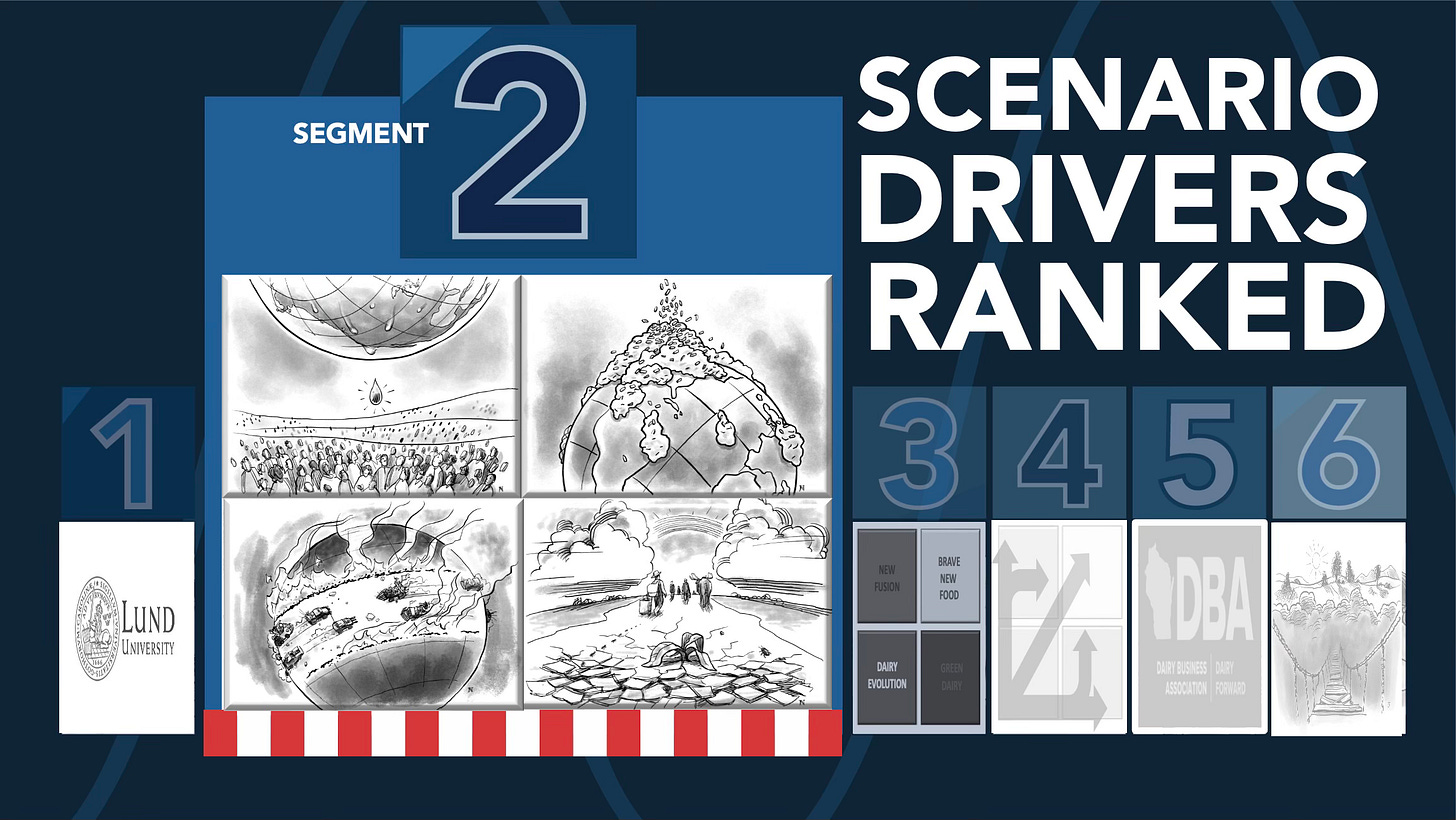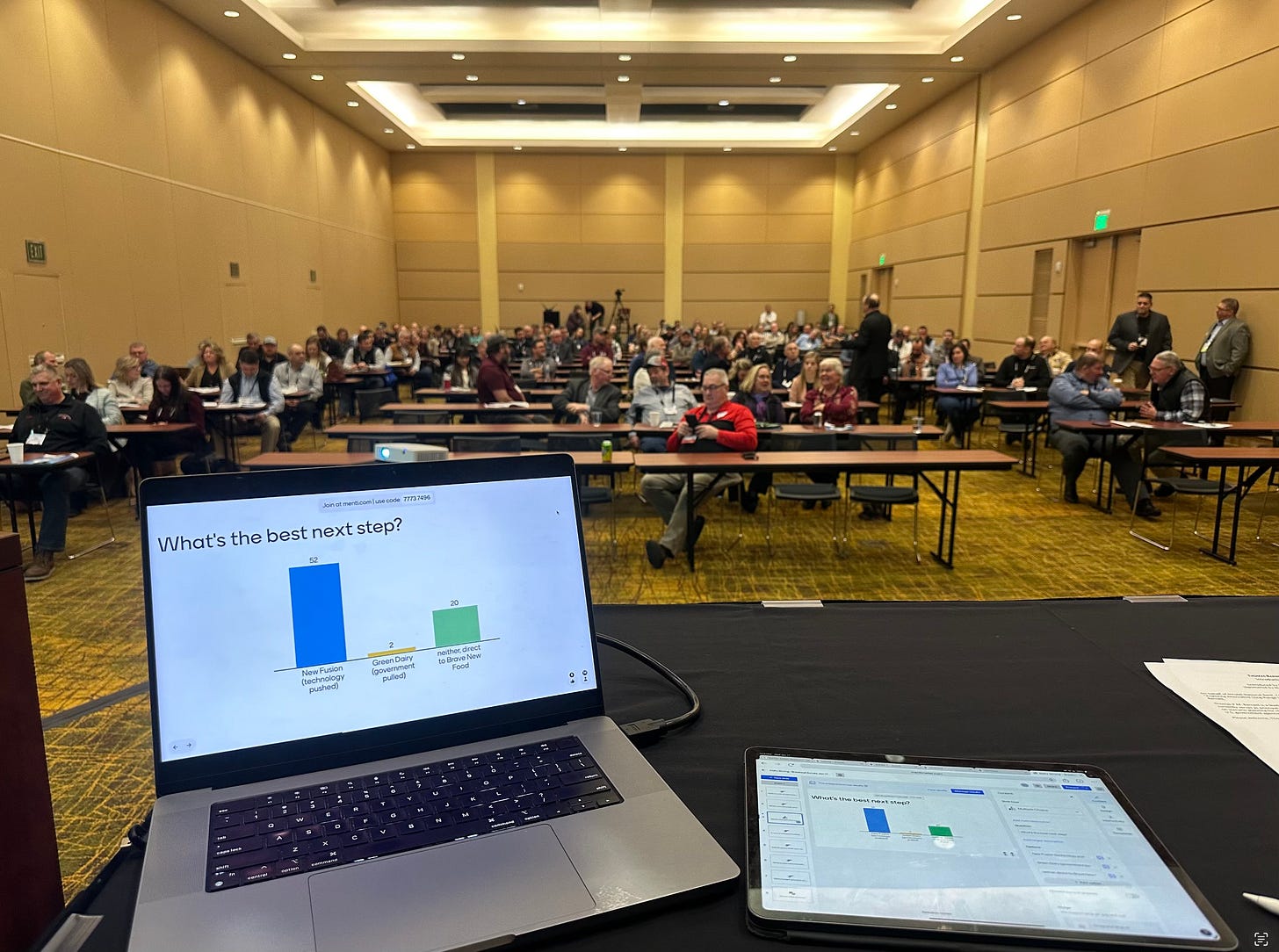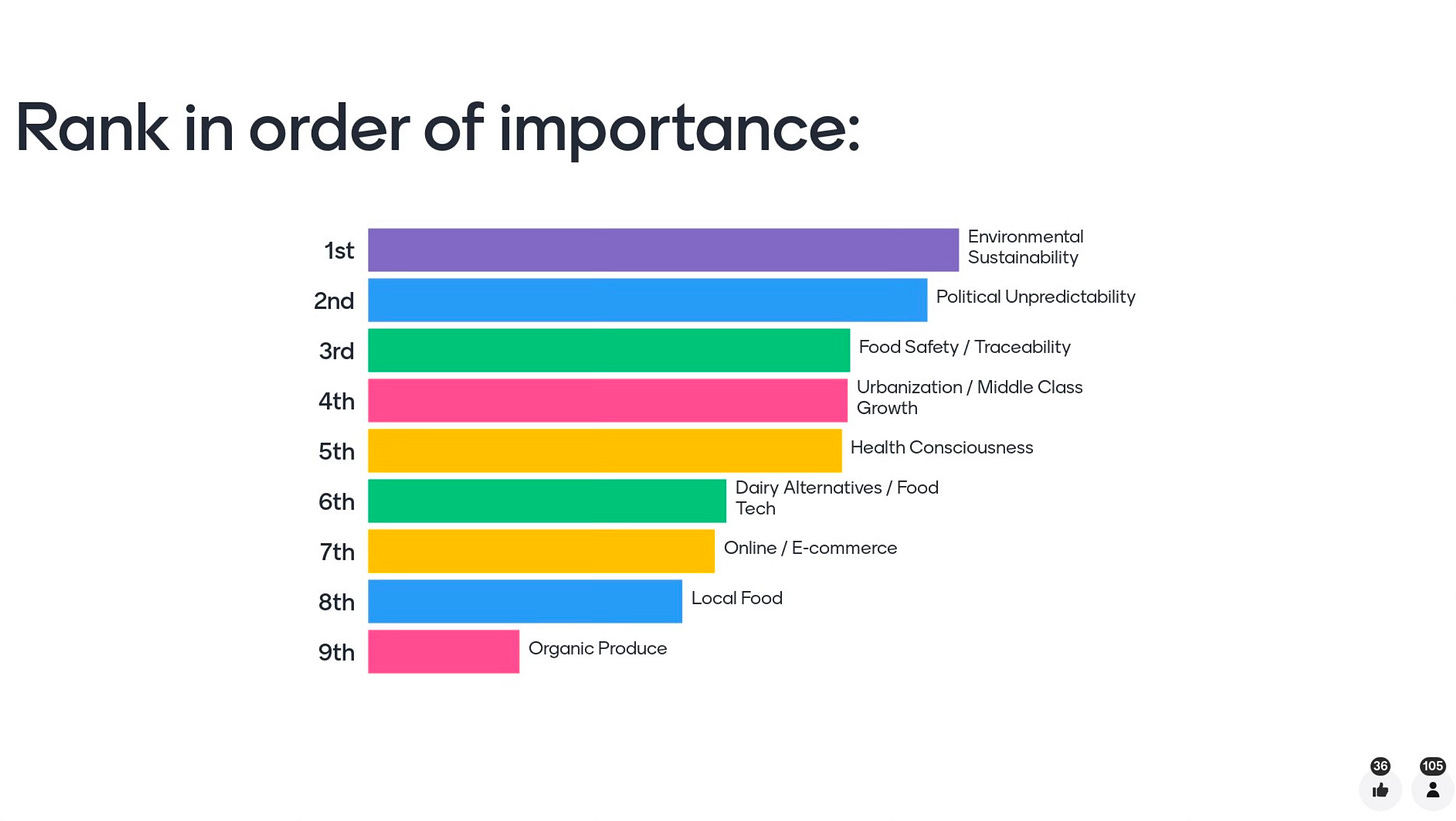Plotting "Dairy's New Map" with a hundred or so Wisconsin dairy farmers
Shared for the record -- and to the participants -- of the Dairy Board Association's 2024 DairyStrong conference in Green Bay WI on 16-18 January 2024
OPENING NOTE
Thank you for your continuous support on my Substack journey and welcome again to all the new subscribers coming out of the DBA Dairy Strong Conference in Green Bay a few days back. If you're wanting more content and a deeper understanding of current events and geopolitical themes, upgrading to a paid subscription opens the door to a wealth of benefits. Gain access to all my current and past Substack writings, engage in direct chats with me (through Substack), and immerse yourself in daily newsletters where I explore and share my perspectives on diverse global events. A paid subscription not only enhances your experience but also fuels the continuation of my work, inspiring meaningful conversations about crucial aspects of our world today. Your support is the backbone that allows me to keep this journey alive, and for that I am grateful.
Wednesday I was the opening keynote for the Dairy Board Association’s (Wisconsin) annual DairyStrong conference in Green Bay, Wisconsin. Not everybody goes all wobbly when receiving an invite to visit Green Bay in January, but I do. Not only was I born just south of GB in Hilton, I’ve had season tickets at Lambeau now for over 20 years, so some of my best memories are of freezing my ass off in Lambeau at playoff games. Needless to say, they had me at “Green Bay.”
I gave a 30-minute version (opening keynote) of the brief for the group as a whole (north of 250), followed by 10 minutes of Q&A. Right after that, I did an on-camera interview with DBA along with a local ag radio interview. Then, with my colleague Tom Zorc, we conducted a workshop for about 90 people. Quick buffet lunch and then I signed about 100 books.
In every instance, the audience/participants were great and it was a real blast for me to be there. I had worked summers on local farms in SW Wisconsin as a teenager (mostly stacking bales in barns — something hardly anybody does today), in addition to growing up in a farm-centric small town of 2,000 (Boscobel), so these are truly my people.
As promised at the event, see the following two downloads for slide decks (saved as PDFs). First, the plenary speech deck:
And then the slide deck from the workshop (the slides of which are recreated below as simple jpegs.
First, to note about the plenary talk: There’s always this fear that you need to customize your presentation for the audience, lest they find it too distant to their everyday lives. You find yourself reading all sorts of material on the subject at-hand but, eventually, you pass on including virtually all of it because — of course — they didn’t bring you there to speak on something they know far better than you. They brought you there to do your thing and to let the chips fall where they may. So, as a rule, the slides don’t change but your delivery frequently brings it all down to how all these forces are shaping the particularly industry/domain. In short, minor customizing on the spot while reading the room (thus, preparation matters).
Still, you wonder: Are they going to want to hear this in all its in-your-face breadth and depth?
And you know what? The answer is always hell yes! You get variations of “we really needed to hear this” and the more edgy one of “I can’t believe you said that to this crowd!”
But, in the end, people are people and people love broad framing because it’s incredibly helpful and calming. They also like something that isn’t all doom-and-gloom (I get those warnings all the time from hosts, as in, “I hope you’re not going to scare us to death and offer no hope for the future — like the last X people we’ve had.”
But, most of all in this instance: farmers are supremely practical people, which makes them the perfect audience for a message that says “these are the inevitabilities, so please consider these inconceivables.” Adapation is in their blood. It is the nature of their business.
So, starting the workshop deck, the idea here (as will be the idea in India soon) is to translate the “new map” mindset of the book into the domain at-hand. The “map” of dairy is being shifted around and re-conceptualized all over the world — thanks to climate change. The human causality can be a tough sell to some, but not the variance and crescendoing change. These people live with weather like nobody else. [Having grown up in Boscobel, I still reflexively pray for good weather throughout the growing season.]
So, the big dynamics to be explored here are caught in the subtitle: Do you want to run with the tech as it pulls you along? Or do you want to attempt to hold your ground against the regulatory/customer/enviro “push”?
We only had an hour and a large audience (90) for a workshop, so we kept things moving along.
In my preparation for the event, I had found this fascinating study from Lund University in Sweden (2021) entitled, “The Future of the Dairy Industry – 2030 Scenario Analysis.”
From the intro:
This white paper reports the findings of a three-year research project conducted by researchers at the Institute of Innovation Management at Lund University’s School of Economics and Management, Sweden. It should be of interest to anyone concerned with the long-range development of the dairy industry in the coming decade – from farm to retail distribution – and with the economic, technical and social forces that are coming to bear on it.
The purpose of this study is twofold:
To drive new insights into the long-term evolution of the dairy industry, broadly conceived across the entire value chain – that is, from farms to consumers.
To help dairy companies and others envision the future and possibly start preparing for taking strategic action.
We are sharing these results with industry players globally, and see this as a platform for exchange and discussion. Data and conclusions have been and will be published in scientific outlets.
We have made a comprehensive and wide-ranging scenario analysis of the global dairy industry. Using a methodology based on identifying predetermined factors (knowns) and potential disruptions from critical uncertainties (unknowns), we arrived at four broad and widely differing scenarios that are plausible descriptions of how the dairy industry will transform itself over the next ten years.
So, basically a classic X/Y quadrant analysis of the industry looking out a decade. I couldn’t believe my luck, frankly, especially as the entire thing is so well done.
So, obviously, having that report and being able to leverage its main points simplified my effort entirely. Perusing the doc, I could tell there was no way I was going to outperform it.
Thus, the structure of the hour is pretty simple: intro the report, tie it into my analysis, then explore the scenarios and compare them to the work/agenda of the DBA (so we could generate some useful feedback for the client).
So, we start off with a quick examination of the report, which is really worth reading.
First off, I wanted to note that the report’s “predetermined events” were basically my trio of system-reshaping “inevitabilities”: climate change, demographic shifts, and that monster of demand — the global majority middle class.
Then I wanted to highlight the similar mindset regarding North-South integration across an industry that is highly consolidated across the North but highly fragmented across the South — where the future growth is concentrated.
Fairly validating, am I right? Follow the global market.
Now on to the analysis from Lund U.
They had generated, through meta-analysis of reports and lots of interviews with industry players, a list of nine key trends.
So, after presenting them, the first step was to get the participants engaged by having them rank them in perceived importance (their perspective). To do that, we flashed a code for them to use at Menti.com for some rapid voting via their smartphones.
That sign-up took all of about two minutes …
We then discussed, with me moderating.
What I noted right off was that the list seemed very upstream from the consumer (until you hit “health consciousness”). To me, that said they viewed these upstream adaptations as a necessary first step before turning to consumer demands.
As one participant adeptly pointed out, if the workshop was for non-farmers, the list probably would have been reversed.
That doesn’t mean the farmers downplay those lower-ranked concerns. It just says they’re more attuned to those upstream pressures first and foremost, meaning they’re responding to the environment more — and before — they’re addressing customer concerns.
Wise?
To me, that’s genuine stewardship and strategic thinking.
The top four dynamics speak to market-making concerns (health of industry), while the bottom five speak to market-playing terms (health of my farm). If you only address the bottom-five, then you’re not thinking ahead.
So, I came away impressed by the thinking. Not surprised, mind you, but impressed.
Jumping to the four scenarios.
Y axis is the what question: what [okay, which] technologies pull you along into the future and how strong are they?
X axis is the how question: how much do consumers, the market, environmentalism, and government regs push you along?
Two questions, four outcomes.
Lower left, by design, is the status quo extended. Upper left and lower right are competing pathways — not mutually exclusive.
Upper right is the promised land, so, admittedly, some normative judgments here.
Names and details pretty straight forward. See the report for more context.
Dairy Evolution is the foreseeable future — not much changed.
New Fusion is the industry racing ahead with tech, looking to fuse productization as much as possible with other competing-but-conceivably-complimentary lines.
Green Dairy is a certain resistance to tech, in part because the regulatory pressures become so strong that they eat up the response.
Brave New Food splits the difference on pathways and synthesizes the best from both — by design.
Scenarios now presented, we do some voting to frame the discussions.
The arrows here suggesting what kind of info we’re looking for: how to leave the status quo behind and get to the best possible outcome near and long term.
So we ask for some votes here, and we did quick discussions on the results as we proceeded.
First off was simply to state your preference.
You can see the tech-angle bias: New Fusion to get to Brave New Food.
Note also that Green Dairy was viewed as less desirable than the status quo (Dairy Evolution).
In discussion: the participants felt like Green Dairy was a Global North bias that proves to be a distraction from the better New Fusion path (more acceptable to Global South), the general logic being that farmers get there (upper right Brave New Food) faster and smarter on their own or with minimal regulatory jerking-around, in large part because those Green Dairy forces often come up with the wrong (too hard, too convoluted, etc.) answers.
In short, the farmers want their decades and centuries of collective wisdom and experience to be more respected by the state. As they point out: they are the last people looking to ruin the land because it’s their livelihood.
The strong preference for tech-pull is seen again in the pathway vote (how best to get from Dairy Evolution to Brave New Food?).
We see the strong preference for the New Fusion pathway, to include ranking a leap-frogging effort (direct to Brave New Food from Dairy Evolution) over the reg-heavy Green Dairy pathway.
This is not a deep resistance to regulatory/enviro concerns but rather a strong preference for chasing the tech and letting the farmers figure it out. Again, this is a strong desire to have their domain expertise respected and leveraged.
I spot expectations matching desire on tech-pull (New Fusion), with the big question being, Do we pull it off or remain stuck in Dairy Evolution?
Despite the clear resistance to the Green Dairy path, there is likewise a sense it will be avoided.
More optimism, in my opinion: a generation from now and we spot strong expectation that reality will fall somewhere between New Fusion and Brave New Food, with far fewer expecting the status quo (Dairy Evolution) to stand.
So, across the two look- ahead votes, a clear pathway emerges:
Short/medium term is journey from Dairy Evolution to New Fusion.
Long term journey is from New Fusion to Brave New Food.
Participants’ perceptions of where DBA’s head is at suggest that the group is well attuned to their expectations and desires. The organization is thinking the right long term and the better of the two pathways there. It is not embracing pointless resistance.
Now a bit deeper dive on DBA.
Pulled from their website, these are their priorities in terms of spending their money.
This vote basically said, How would you prioritize DBA’s goals.
Interesting to see global market as key, followed by improving KAFO (KAY-foh) operations (750 cows and above) to facilitate higher production to meet that demand.
Then concern for fresh-water usage, followed by tech advancement.
Local infrastructure last, which either says other problems more important and/or the situation is decent enough for now.
Finally, and in keeping with DBA warnings to not be all doom-and-gloom (they heard that from participants wary of yet-another presentation that made them feel like their life’s work was a complete disaster). we repeat the longer-term optimism of the ANM brief by looking downstream at how things could be improved — beyond what’s already being done.
So we asked, What is DBA missing?
A collection of inputs:
A mix of market-operational concerns, the mechanics of bringing on and supporting the next generation of farmers (always a big worry), and a split call on politics (Love Trump, Hate Trump, some bipartisanship please!).
It was a great hour, and we drew the biggest crowd of the three breakout sessions. We heard back from a lot of the participants (the bulk of those sought signed book copies at lunch) about how the brief was great but the deeper dive on the domain really drove home some key points and understanding.
It was, in the end, a very validating experience for us in terms of applying the big-picture ANM analysis to a particular industry.
Now, on to India!
My thanks to all involved: not just my immediate boss Tom Zorc who was on-hand, but likewise to support crew (Maura Collins, Liz Gaither) back home at Throughline’s HQ.
It was, I feel confident to say, a good time had by all.
We’re hoping to turn this experience into lots of other brief + workshop package deals, so don’t be shy in suggesting what those engagements could be.
Oh, and Go Pack, Go!


































